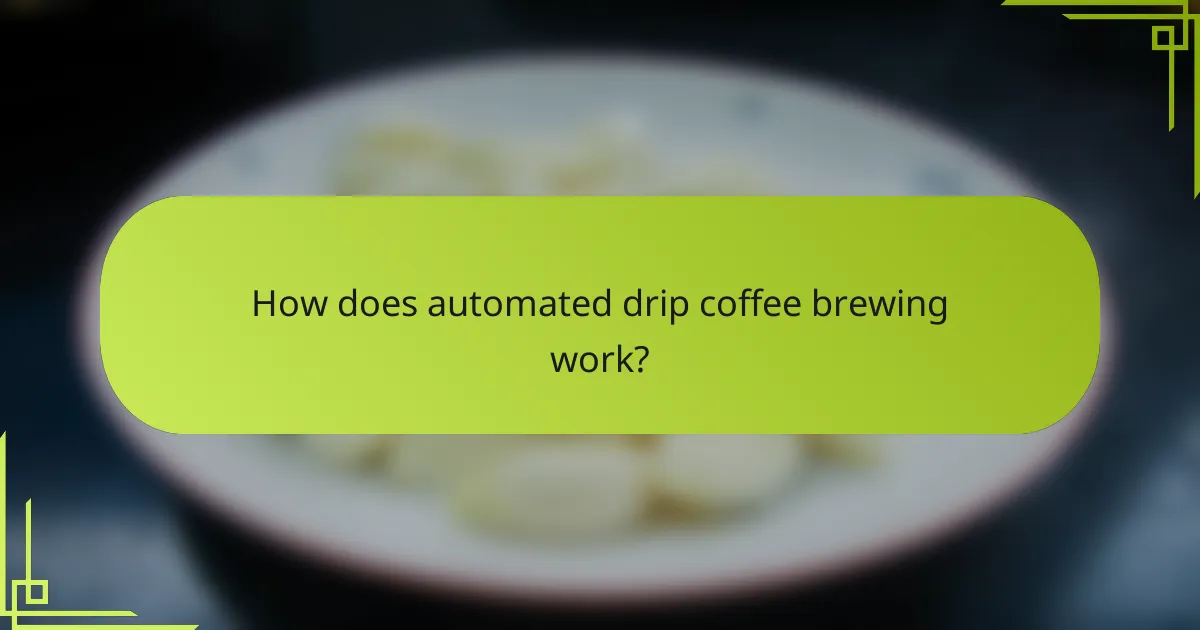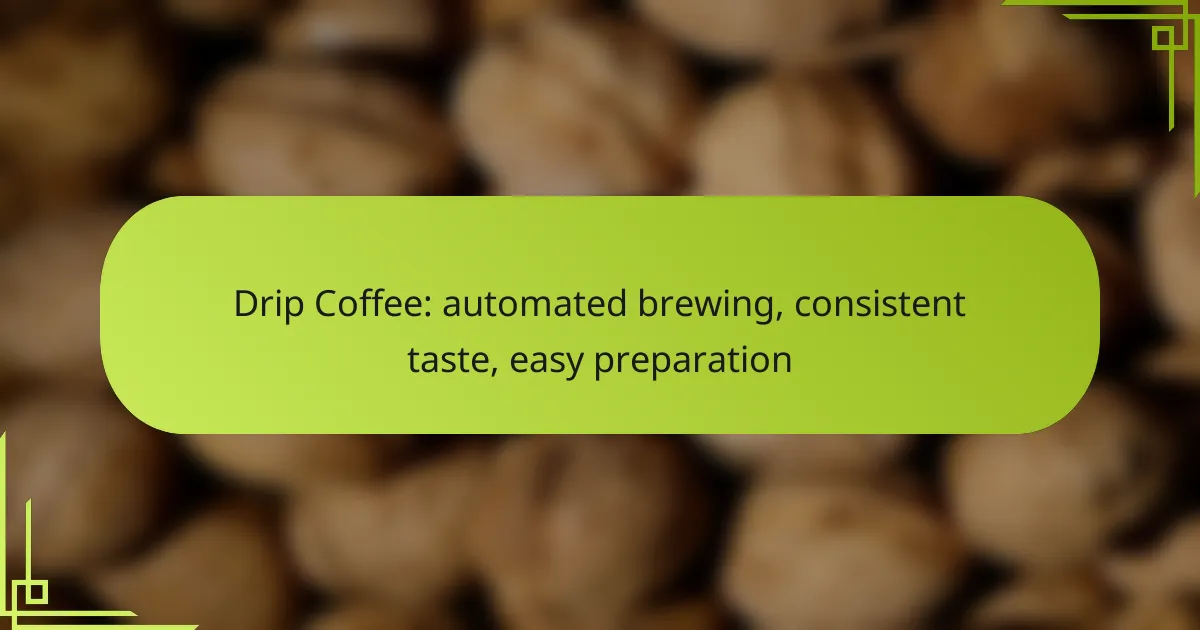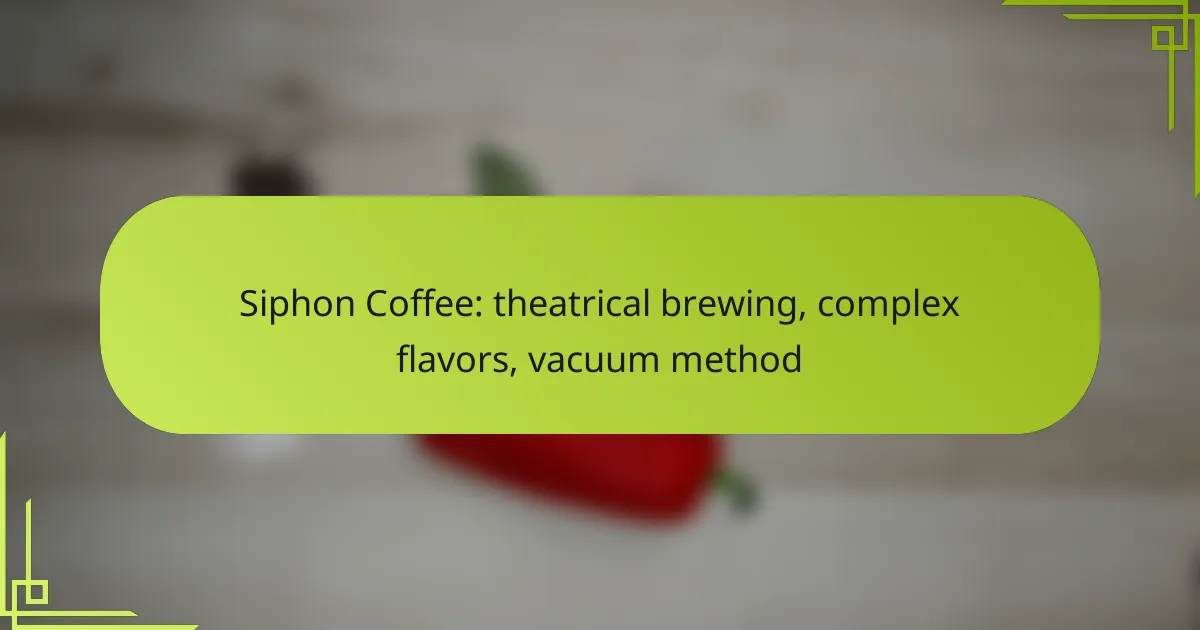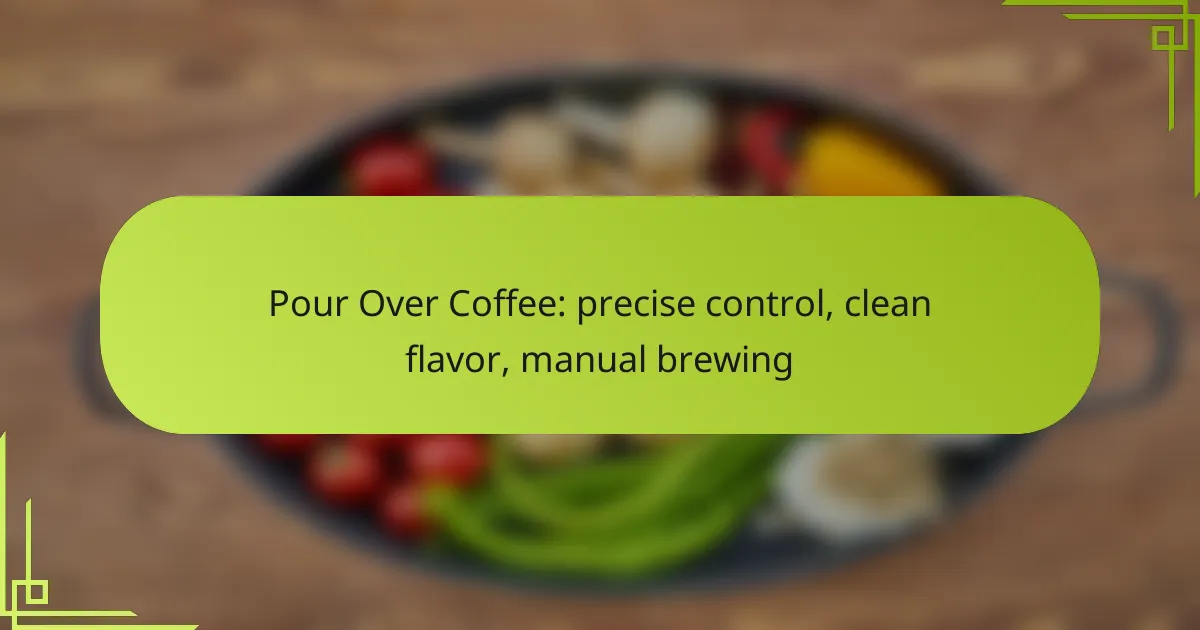Drip coffee makers revolutionize the brewing process by automating the extraction of flavors and aromas, resulting in a consistently delicious cup of coffee. Their user-friendly design and time-saving capabilities make them ideal for both coffee enthusiasts and casual drinkers alike. With the right model, you can enjoy a perfectly brewed cup with minimal effort, ensuring a reliable taste every time.

How does automated drip coffee brewing work?
Automated drip coffee brewing involves a machine that heats water and passes it through coffee grounds, extracting flavors and aromas to create a consistent cup of coffee. This method is popular for its simplicity and ability to produce coffee with a uniform taste, making it a staple in many households and offices.
Mechanism of drip coffee makers
Drip coffee makers operate by heating water in a reservoir and then directing it through a showerhead onto coffee grounds placed in a filter. The hot water seeps through the coffee, extracting oils and flavors before dripping into a carafe below. This process typically takes a few minutes, allowing for a balanced extraction.
The brewing time and water temperature are crucial; most machines aim for a brewing temperature between 90°C and 96°C (194°F to 205°F) to optimize flavor extraction. A well-designed drip coffee maker ensures even saturation of the coffee grounds for a consistent brew.
Key components of automated brewing systems
Automated drip coffee makers consist of several key components: the water reservoir, heating element, brew basket, filter, and carafe. The water reservoir holds the water, while the heating element heats it to the desired temperature. The brew basket holds the coffee grounds and filter, and the carafe collects the brewed coffee.
Many modern machines also feature programmable settings, allowing users to set a timer for brewing, which can enhance convenience. Some models include built-in grinders for fresh coffee grounds, adding to the flavor profile of the final brew.
Temperature control in brewing
Temperature control is vital in automated drip coffee brewing, as it directly impacts the extraction process. The ideal brewing temperature is generally between 90°C and 96°C (194°F to 205°F), which helps extract the right balance of flavors from the coffee grounds. If the water is too hot, it can lead to over-extraction, resulting in a bitter taste.
Many drip coffee makers come with built-in temperature control features to maintain this optimal range. Users should regularly check their machines for consistent performance and consider using a thermometer to monitor water temperature if precision is desired.

What are the benefits of using drip coffee makers?
Drip coffee makers offer several advantages, including consistent taste and quality, time-saving preparation, and ease of use for beginners. These machines automate the brewing process, ensuring a reliable cup of coffee with minimal effort.
Consistent taste and quality
Drip coffee makers are designed to deliver a uniform brewing temperature and extraction time, which helps achieve a consistent flavor profile. By using the same coffee-to-water ratio and brewing parameters, you can replicate your favorite cup day after day.
Many models allow you to adjust settings such as brew strength and temperature, giving you control over the final taste. This consistency is particularly beneficial for those who appreciate specific flavor notes in their coffee.
Time-saving preparation
Using a drip coffee maker significantly reduces the time spent preparing coffee compared to manual methods. Most machines can brew a full pot in about 5 to 10 minutes, allowing you to multitask during the process.
Additionally, many drip coffee makers come with programmable features, enabling you to set a brew time in advance. This means you can wake up to freshly brewed coffee without any morning hassle.
Ease of use for beginners
Drip coffee makers are user-friendly, making them ideal for those new to brewing coffee. Most models require just a few simple steps: add water, insert a coffee filter, and fill it with ground coffee.
With clear instructions and minimal setup, beginners can quickly learn how to operate these machines. This accessibility encourages more people to enjoy home-brewed coffee without the intimidation of complex brewing techniques.

Which are the best drip coffee makers available?
The best drip coffee makers combine automated brewing, consistent taste, and easy preparation. Key models to consider include those that offer customizable settings, reliable performance, and user-friendly features.
Breville BDC450 Precision Brewer
The Breville BDC450 Precision Brewer is designed for coffee enthusiasts who appreciate control over their brewing process. It features six brewing modes, allowing you to tailor the temperature and brew time to your preference.
This model includes a pour-over adapter, enabling you to brew coffee similar to manual methods. With its precise temperature control and adjustable bloom time, you can achieve a rich and flavorful cup every time.
Technivorm Cup-One Coffee Brewer
The Technivorm Cup-One Coffee Brewer is ideal for those who prioritize single-serve convenience without compromising on quality. This brewer heats water to the optimal temperature for extraction, ensuring a consistent taste in every cup.
Its compact design makes it perfect for small kitchens or office spaces. Simply add coffee grounds and water, and in a few minutes, you’ll have a freshly brewed cup ready to enjoy.
Cuisinart DCC-3200P1 Perfectemp Coffee Maker
The Cuisinart DCC-3200P1 Perfectemp Coffee Maker offers a balance of features and affordability. It has a 14-cup capacity, making it suitable for larger households or gatherings, and includes a programmable timer for added convenience.
This model allows you to adjust the brew strength, catering to both mild and bold coffee preferences. Its self-cleaning feature and dishwasher-safe parts simplify maintenance, making it a practical choice for everyday use.

What factors should you consider when choosing a drip coffee maker?
When selecting a drip coffee maker, consider brewing capacity, programmable features, and price range along with warranty options. These factors directly influence the convenience, efficiency, and overall satisfaction of your coffee brewing experience.
Brewing capacity
Brewing capacity refers to the amount of coffee a machine can produce in one cycle, typically ranging from 4 to 12 cups. If you often entertain guests or have a large household, a higher capacity model may be more suitable. Conversely, for individual use or small households, a smaller capacity can save counter space and reduce waste.
Consider how often you brew coffee and the number of servings you typically need. Some machines also offer a single-serve option, allowing you to brew just one cup at a time, which can be a practical choice for those who drink coffee sporadically.
Programmable features
Programmable features enhance convenience by allowing you to set brewing times in advance. Many modern drip coffee makers come with timers, auto shut-off, and brew strength settings, enabling you to customize your coffee experience. Look for models that allow you to program the machine to start brewing at a specific time, ensuring your coffee is ready when you wake up.
Additional features like a built-in grinder or a thermal carafe can also improve your brewing experience. However, ensure that these features align with your brewing habits to avoid unnecessary complexity.
Price range and warranty
Drip coffee makers vary widely in price, typically ranging from around $20 to several hundred dollars. Higher-priced models often come with advanced features, better build quality, and longer warranties. Determine your budget and consider what features are essential for your needs.
Warranties can provide peace of mind, especially for higher-end machines. Look for models that offer at least a one-year warranty, as this indicates the manufacturer’s confidence in their product’s durability and performance.

How to maintain your drip coffee maker?
Maintaining your drip coffee maker is essential for ensuring consistent taste and longevity. Regular upkeep includes cleaning, descaling, and replacing worn parts to keep your machine brewing at its best.
Regular cleaning tips
To maintain your drip coffee maker, clean it regularly by washing removable parts like the carafe and filter basket with warm, soapy water. Wipe down the exterior and the warming plate to remove any coffee stains or spills.
Run a cycle with a mixture of water and white vinegar every month to help eliminate coffee oils and residue. Rinse thoroughly afterward to prevent any lingering vinegar taste in your coffee.
Descaling process
Descaling is crucial for removing mineral buildup from hard water, which can affect the performance of your coffee maker. Use a descaling solution or a mixture of equal parts water and white vinegar, filling the reservoir and running a brew cycle.
After the descaling cycle, run two or three cycles with clean water to flush out any remaining solution. This process should be done every few months, depending on your water hardness.
Replacing filters and parts
Regularly check and replace the water filter in your coffee maker, if applicable, to ensure the best taste. Depending on usage, this may be every two to three months.
Inspect the coffee maker’s parts, such as the brew basket and carafe, for wear and tear. Replace any damaged components to maintain optimal brewing performance and prevent leaks.

What are common mistakes to avoid with drip coffee brewing?
Common mistakes in drip coffee brewing can lead to inconsistent flavor and poor extraction. By avoiding these pitfalls, you can enhance your coffee experience significantly.
Using the wrong coffee grind
Using the incorrect coffee grind can drastically affect the taste of your drip coffee. A grind that is too coarse may result in under-extraction, leading to a weak flavor, while a grind that is too fine can cause over-extraction, resulting in bitterness.
For drip coffee, a medium grind is typically recommended, resembling granulated sugar. This grind size allows for optimal extraction during the brewing process, striking a balance between flavor and strength.
To ensure you’re using the right grind, consider investing in a burr grinder, which provides a consistent grind size. Avoid pre-ground coffee, as it may not meet your specific brewing needs and can lose freshness quickly.










